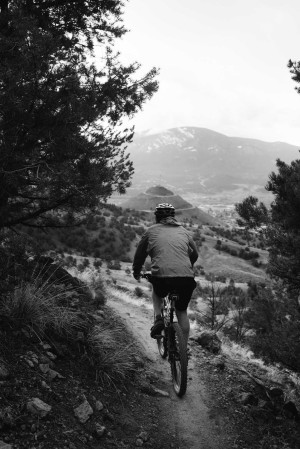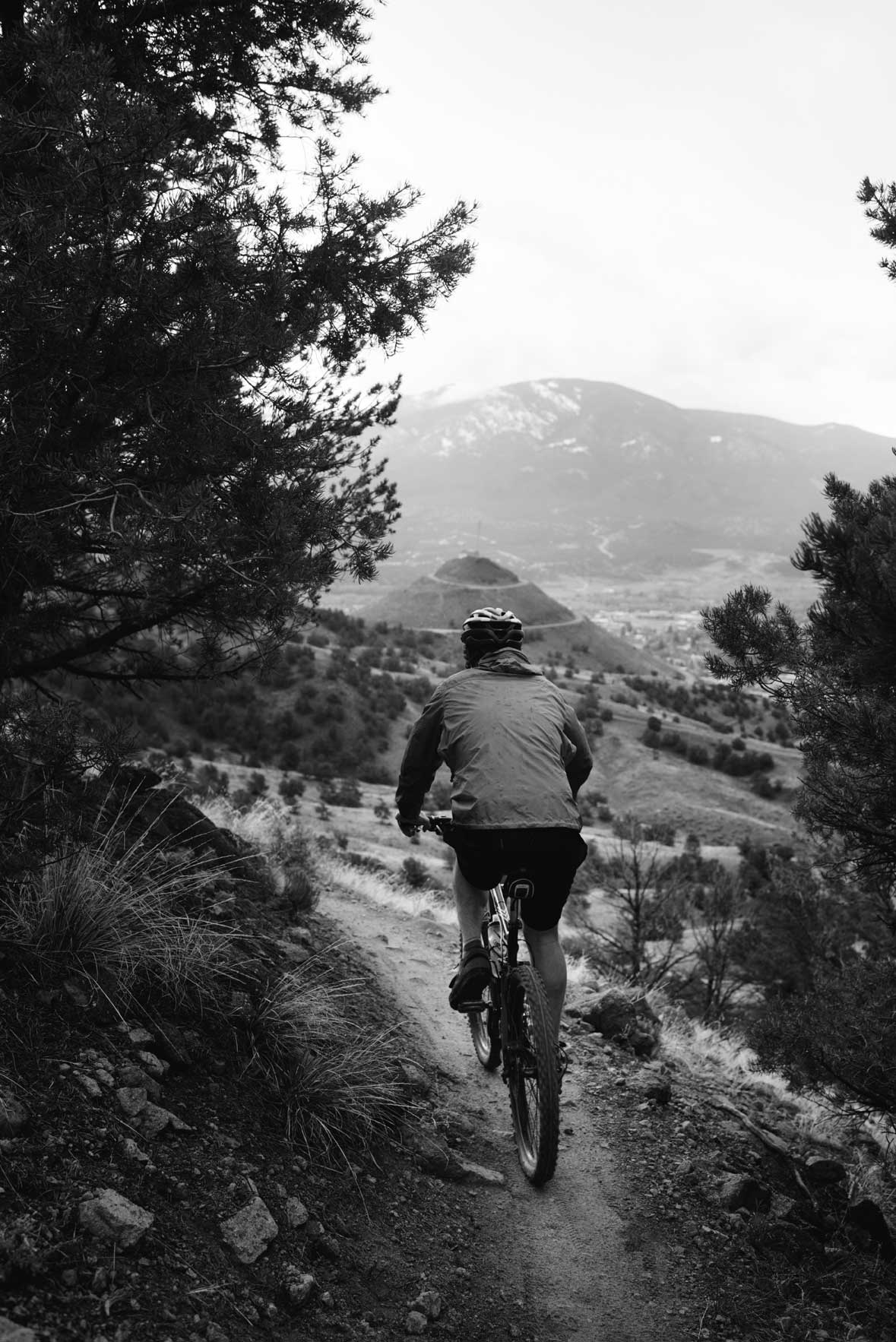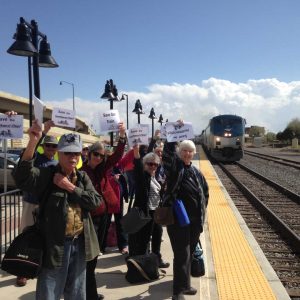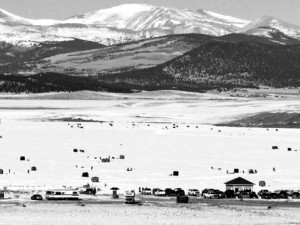by Tyler Grimes
This year, an estimated 10,000 recreationalists will utilize the Arkansas Hills and Methodist Mountain trail systems near Salida. Singletracks.com selected Salida’s trails as the number five spot on its “Top 10 Mountain Bike Destinations in North America.” The January edition of Elevation Outdoors featured Salida for its year-round mountain biking possibilities. Given the weather and quality of riding, the growing popularity of Salida trails is no surprise; the shock is that most trails did not exist 10 years ago. Locals and visitors who ride the trails, and business owners who benefit from the increased tourism the trails bring, all have Salida Mountain Trails (SMT) to thank.
“I was at a party one night with my cousin Nathan (Ward), and Yvonne Barnes,” recalled Tom Purvis over a beer. “There was a rumor goin’ around that the BLM was updating their Travel Management Plan (TMP). So we were like, Tthis is our chance to do something.’” The next day Purvis contacted Shawn Gillis, owner of Absolute Bikes. Soon others like Tony Boone, owner of Tony Boone Trails LLC, began to get involved as planners and mentors to the groups, and the organization that would become Salida Mountain Trails was born. Their original mission was to protect use on the few trails that existed, namely unsustainable “bootleg” versions of Sand Dunes and Lost Trails. A few months later, Purvis remembers getting a call from Ward with the idea to shift the focus from protecting a few trails to “telling them what we want.” and working to create new trails.

The next step was creating a 30-page plan complete with trail descriptions and maps to submit to the BLM, a document later included in the TMP. The first two directors of SMT, Andrew Mesesan and Purvis, worked as employees of Absolute Bikes to map and identify trails, and literally start the groundwork. The first trail built was Tenderfoot, which didn’t require BLM approval because it was on city-owned land. “We started and completed Tenderfoot in April 2006,” said Purvis, “because so many people were hungry to get out and work on trails.”
Mesesan built trails by hand, led volunteer crews and mapped future trails. Mesesan paused from a fork rebuild at Salida Bike Company, where he now wrenches, and recalled his work on some of the first trails accessible from downtown. “I built the lower portion, up to Spiral Drive, pretty much entirely by hand. The upper half, to Backbone, was done mostly with a rented excavator.”
“It took five years from when we first started meeting to putting a shovel on the ground,” said Shawn Gillis, referring to BLM trails. Gillis is currently vice president of SMT. The first project on BLM trails was the Backbone Trail, from CR 173, and Sand Dunes, completed by volunteers between November 2008 and February 2009, providing a “stacked-loop” system that allows more combinations of riding, with easier trails more accessible. “That’s one of the things that makes this system unique; the trails are bi-directional,” says Gillis, “so you can ride down one section and go back up for a different trail.”
SMT has always been diligent in making or rerouting trails to be sustainable using techniques like grade reversal, which makes trails more fun with up and down features, but also more drainable. Before original trails like Sand Dunes and Lost were rerouted, they stayed in the wash, causing them to lose vegetation and erode faster. Riders can still see some of the scars left along the old route. “Now Sand Dunes, for example, is a trail people could ride over and over again with very little impact,” said Gillis.
SMT trails are one of only a few systems under four different land management agencies: the BLM, the Forest Service, the City of Salida and Colorado State Parks. Josh Osterhoudt, formerly part of Medicine Wheel Trail Advocates in Colorado Springs, advised collaboration when SMT was beginning. Osterhoudt told Purvis and SMT to empathize with the land managers. “It’s easy to place them as the obstacles until you put yourself in their shoes and think about all that they are thinking about and dealing with on a regular basis, like protecting natural resources,” said Purvis. “Working with land managers to reach consensus is the hard part; building trails is easy.”
The collaboration of stakeholders has been vital to SMT’s success, especially among its labor. “I would say 70 percent were built by volunteers,” said Gillis of trail construction. One Saturday a month, SMT hosts a “shindig” to get volunteers out repairing old trails or expanding new ones. Donations, grants and fundraisers pay for contracted trail crews. SMT membership is an important income source – last month’s membership drive raised $9,100. The Boathouse and River’s Edge restaurants add one percent of the total to customers’ bills to donate to SMT, an effort that raised nearly $15,000 in 2014. Those income sources, along with others, are what allow SMT to continue maintaining and building what’s become a valuable asset to the community.
[InContentAdTwo]
Trail Expansion
Mike Sugaski has been a leader for SMT since its inception, first as a Forest Service employee, later as board president, and currently as a board member overseeing future trail projects. Sugaski said SMT’s most immediate plans are fine-tuning the Sweet Dreams Trail, nearly completed at the May shindig with volunteers, then moving on to the Lowry Loop, a 1.5-mile trail between Sweetwater Gulch and the Arkansas River. The loop will be on the Lowry Ranch, 80 acres recently purchased by the City of Salida, and will feature a hiking trail to a scenic overlook.
Beyond volunteer-constructed trails, SMT has contracted Arrowhead Trails to add 2.5 miles of single- track to the Cottonwood Trail. That project is scheduled to begin before the end of May, paperwork pending, and be completed by the end of the summer. The Cottonwood Trail’s completion is funded by a Colorado Parks and Wildlife Trails Construction Grant.
In 2014, SMT submitted 12 miles of trail proposals for analysis. The majority of those 12 miles are expansions to the Methodist Mountain System. Currently, the BLM is backlogged in reviewing new trail requests because it’s shorthanded. According to Sugaski, the Royal Gorge Field Office’s recreation manager has been summoned to work in Denver, leaving the river manager to fill in. SMT board member, Tom Jacobson has been analyzing and sorting public comment to help speed the BLM process. “Ninety-five percent of the comments are positive,” says Sugaski.
The best way to get involved with Salida Mountain Trails is to join a shindig and work on trails. “It’s kinda therapeutic to get out there and piddle around in the dirt,” said Sugaski. To learn more about SMT, become a member or find out about upcoming events visit:
SalidaMountainTrails.org.




